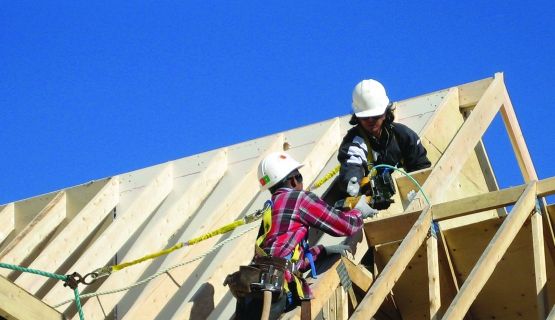Health and safety training
IWH research on occupational health and safety (OHS) training focuses on its effectiveness—from the effectiveness of delivery methods and contents to the effectiveness of training programs overall. OHS training, mandated by workplace health and safety laws in jurisdictions across Canada and beyond, is considered an important part of managing workplace hazards and risks. Such training may involve instruction on identifying occupational risks and how to control them, learning about safe workplace practices and how to properly use personal protective equipment.
Featured

Research Highlights
In-person or online: Does it make a difference for OHS training?
Online formats for occupational health and safety (OHS) training have gained popularity in recent years, especially since the COVID-19 pandemic. But are they as effective as in-person training?
Published: April 4, 2025

Impact case study
IWH evaluation of the effectiveness of the Ontario working-at-heights training standard
An IWH study on the effectiveness of Ontario's mandatory training was valuable to the labour ministry in several ways—including in reinforcing the value of program evaluations.
Published: November 21, 2023
IWH Speaker Series
IWH Speaker Series
Evaluating the implementation and effectiveness of Ontario’s working-at-heights training standards
In 2015, Ontario's Ministry of Labour implemented regulations defining working-at-heights (WAH) training program standards and establishing a program for approving training providers in the province. In this presentation, Dr. Lynda Robson shares findings from a study that examined the reach and effectiveness of the training standard.
Published: February 2019
Project report
Project report
Evaluation of the implementation and effectiveness of the Ontario working-at-heights training standard: final report
The Institute for Work & Health shares the findings from its evaluation of the implementation and effectiveness of a mandatory working-at-heights training program introduced in Ontario in 2015. Ontario employers were required to ensure that workers on construction projects who worked at heights had successfully completed the training by October 2017.
Published: February 2019
IWH Speaker Series
IWH Speaker Series
Assessing workplace training for skin exposure prevention
For almost 20 years, the Centre for Research Expertise in Occupational Disease has studied skin exposure prevention strategies, including worker training on this common hazard. In this presentation, Dr. Linn Holness shares research findings on training effectiveness, highlighting gaps, barriers and facilitators to training implementation.
Published: December 2018
Journal article
Journal article
The effect of active and passive occupational health and safety (OHS) training on OHS awareness and empowerment to participate in injury prevention among workers in Ontario and British Columbia (Canada)
Published: Safety Science, October 2018
Journal article
Journal article
Occupational health and safety vulnerability of recent immigrants and refugees
Published: International Journal of Environmental Research and Public Health, September 2018

IWH in the media
Baranyai: Workplace training key for safety of newcomers
A local store manager was eager to help newcomers from Syria find employment, but he made something clear. Before they could work a single shift, they would need sufficient language skills to complete job safety training. This safety-first approach is not a universal experience among recent immigrants, according to a study by the Institute for Work & Health, writes columnist Robin Baranyai.
Published: The London Free Press, April 2018

At Work article
Embedding essential skills training in OHS lessons can boost learning: study
The work of rigging and hoisting loads comes with significant hazard. Adding to the injury prevention challenge is the fact that many people doing this work have literacy and numeracy skills gaps. A recent IWH study tried out a novel approach to address these learning needs.
Published: April 2018

Tools and guides
Essential Skills and OHS Training
This guide, based on a research collaboration led by the Institute for Work & Health, provides an overview of the process involved in modifying the curriculum of an existing occupational health and safety (OHS) training program in order to address gaps in essential skills among worker trainees.
Published: April 2018
Project report
Project report
Safe employment integration of recent immigrants and refugees
This report details the findings of an Institute for Work & Health study on employment preparation process of newcomers in Ontario, with the aim of determining key training and resource needs and opportunities related to safely integrating recent immigrants and refugees into the labour market.
Published: March 2018

At Work article
Newcomers often lack OHS protection and information in their precarious first jobs
They face difficulty finding work, due to language barriers, foreign credentials or lack of Canadian experience. Their first jobs are precarious, sometimes unpaid. To top it off, they receive next to no training on OHS and employment standards issues, as a new IWH study has found.
Published: February 2018